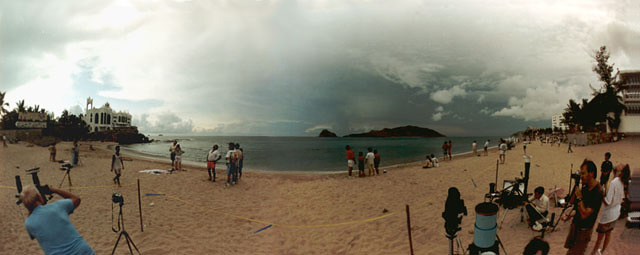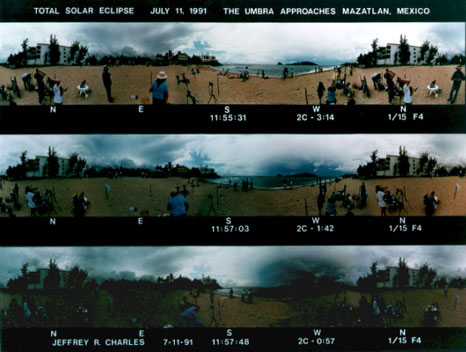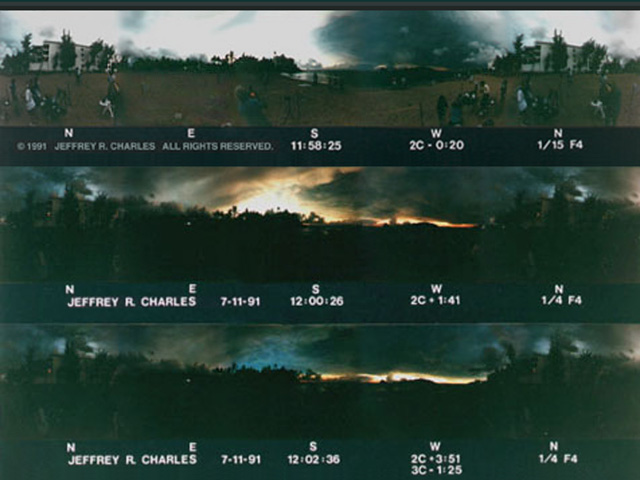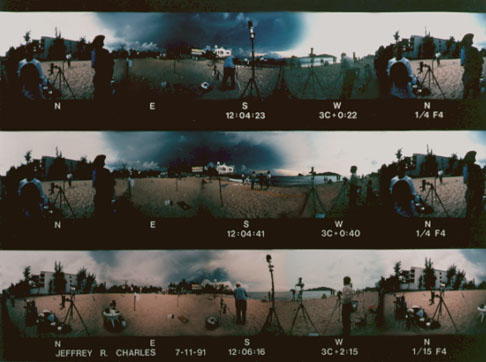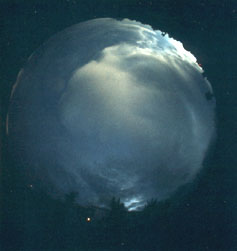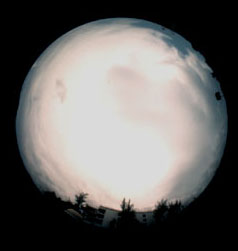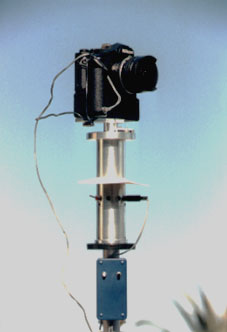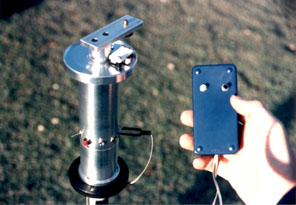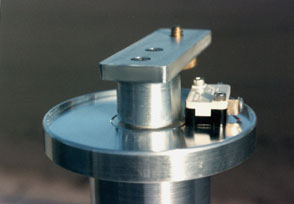| The total solar eclipse of 11 July 1991 was my second total solar eclipse. It was observed from Mazatlan, Mexico. Mazatlan was selected for budgetary reasons. A trip to Mazatlan including lodging cost less than half as much as an eclipse tour to Cabo, etc. The weather prospects were not as good in Mazatlan, but the probabilty of clear skies was still above 50 percent. The trip was short, so I did not get to take pictures of Mazatlan itself.
The only other total solar eclipse I had seen was on 26 Feb. 1979 in Montana. The lunar umbra had put on quite a show in 1979, and some of the best views were under circumstances I did not anticipate. For example, yellow and orange color was visible just below the leading edge of the umbra only seconds after totality began, and motion of the umbra boundary was obvious. Totality was visible through thin clouds in 1979, but it took a back seat to seeing the umbra move down toward the eastern horizon, eating up the the blue sky beyond as it went.
Because it appeared that the umbra could put on a good show in almost any direction, I decided to take a series 360 degree panoramas at the 11 July 1991 total solar eclipse. These would capture the entire horizon, and thus any impressive effects of the lunar umbra, regardless of the time or direction. Each panorama consisted of four photos taken with a Nikon FM camera and a 16mm f/2.8 Fisheye Nikkor lens working at f/4.
One limitation was film. Since each panorama required four pictures, I could only take nine panoramas. There was no time to change film. I ended up taking 12, with the final three being hand held with the camera body from my telescope. However, the first three were taken so early that the umbra made only subtle changes in the western sky. At this eclipse, the umbra was theoretically be detectable as long as nine minutes before totality in a clear sky. However, clouds in our area kept it from being visible until about five minutes before totality.
Instrumentation consisted of a Vernonscope 94mm f/4 triplet refractor on an Aus-Jena equatorial mount, and a Sony TR-7 camcorder with a 3x converter, both for the corona.
Wide angle cameras included a Nikon FM with MD12 motor drive and 16mm f/2.8 Fisheye Nikkor lens on my home made motorized indexing panoramic platform to take 360 degree panoramas. The motorized platform was built to facilitate taking each 360 degree panoramia in only 6 seconds, in order to minimize "time distortion" in the final image.
Additional items included a Pentax H2 camera with a Soligor fisheye attachment mounted on an Argus 50mm f/3.5 Coated Cintar lens (from an Argus C3) via a custom T-mount cell. A borrowed Sony camcorder with a 0.5x wide angle attachment was pointed west to capture the approaching umbra. A Gossen Luna-Pro meter was used to measure incident light levels.
The Eclipse Begins:
The sun is in the clear when the partial phase of the eclipse begins at 10:32 a.m., but by 11:20, the sun is intermittently obscured by clouds. The clouds are a combination of high clouds through which it might be possible to see the inner corona, along with low clouds that are moving from the mountains toward the shore, though I did not know it at the time. It was not possible to distinguish between the two, but my all-sky pictures showed this was the case.
By 11:45, 14 minutes before totality, the ambient light is clearly muted, and color on everything around us seems to be graying out. The exposure for ISO 125 film is 1/125 second at f/4. A few minutes later, the sky low in the west begins to darken a little.
At 11:55, just 4 minutes before totality, the clouds are thin enough to see the shrinking crescent sun. It's dim, but well defined. It looks like we might get to see at least prominences and the inner corona. Ambient light now meters at 1/15 second at f/4. Darkness in the western sky is more pronounced and its width has enlarged to about 60 degrees, though it does not reach very far up into the sky. As it slowly grows, it widens more toward the south than toward the north, since we are situated well north of the eclipse center line.
By two minutes before totality, the umbra is obvious to everyone as it dominates the western and southwestern sky. The trailing edge of the umbra soon clears the western horizon, revealing returning sunlight beyond as a muted orange color.
With only one minute to go before totality, motion of the umbra is obvious as it covers a cloud bank well to the southwest, while also being visible on high clouds beyond. A pale yellow color illuminates distant clouds immediately in front of the umbra. To the west and southwest, color beyond the trailing edge of the umbra is becoming a more saturated orange color. A few seconds later, umbra is so large I cannot see it all at once, but I can still tell it is getting larger. We are being engulfed, and it is exciting!
At 11:58:25, totality is only 20 seconds away. The crescent sun is still visible, though it is less defined. Ambient light is dimming as fast as lights in a theatre before a movie, and the sun begins to look like an indiscinct spot of light rather than a crescent. Its light becomes harder to see, then it simply disappears into the gray clouds overhead. Apparently, the clouds are too thick for seeing the corona, and scattered light from outside the umbra makes the clouds look dark gray instead of black.
The ground looks dark, but not black. Ambient light now reads 3 seconds at f/4 on the meter. Meanwhile, color at the distant leading edge of the umbra has become a fairly saturated mixture of yellow, orange, and even red light. We are now in the moon's shadow.
And so, we didn't see the corona. But the lunar umbra put on an excellent show, as you will see in the 1991 eclipse panoramas below!
© Copyright 1991, 1997, 2017 Jeffrey R. Charles, All Rights Reserved.
| 